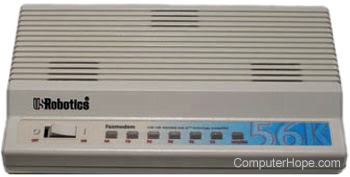How to troubleshoot a modem in Windows NT 4.0

Because Windows NT is a non plug and play operating System, it's extremely unlikely when installing a modem that it automatically installs. The steps below are instructions for installing a Modem in Windows NT.
Windows NT 4.0 modem troubleshooting
Ensure you have Windows NT drivers; it is very common for modem manufacturers to only ship Windows 95/98 drivers.
If you have a WinModem, contact the manufacturer to make sure it is compatible with Windows NT.
After the installation of the Modem, install the latest Service Pack.
Get into the Control Panel - Click Start, Settings, and Control Panel.
Open Modem Properties - Double-click the modem icon.
Install Modem - If the modem is not installed yet, you get a prompt for Windows NT to detect the modem. Allow Windows NT to install the Modem. If it does not detect the modem, manually install the modem. When manually installing the modem, if you have drivers press the button Have Disks and specify drivers location.
Setup Modem - During the setup of the modem specify the port of the modem COM1, COM2, COM3, or COM4. It only displays available COM ports or ports currently installed on the computer.
Installing and setting up dial-up networking (connecting to Internet)
Follow these steps to install dial-up networking in Windows NT 4.0.
Install Dial-up Networking
Open My Computer and double-click the Dial-up Networking icon. (If this icon is missing, skip to missing Dial-up Networking).
Next, install the files on your hard drive. Point to your i386 directory on your Windows NT CD (compact disc) (sometimes on the hard drive) to begin installation.
During the installation, if an RAS service is not already added, let the installation configure the RAS for you. During the installation of the RAS service, you must install the modem to be used for the RAS service.
Once the RAS service is installed, click the Continue button to continue with the installation of the dial-up Networking.
Once Dial-up Networking is installed, reboot the computer to complete the installation.
Once the computer has rebooted, open My Computer and double-click dial-up Networking. At this point a message indicating no phone books were located should appear.
Installing a phone book
Specify the name of the dial-up Networking (e.g., the name of your Internet service provider).
Check the box 'I am calling the Internet,' and click Next. If you receive a message about TCP/IP not being installed, cancel, close all windows, and skip to the next section before continuing with this section.
Enter the phone number to dial your Internet service provider, click the Dial button to begin dialing, and specify your user information and domain if required.
Installing TCP/IP and setup
Click Start, Settings, Control Panel, double-click the Network icon. Click the Protocols tab, click the Add button, add the TCP/IP protocol.
During the installation of TCP/IP you are prompted if your network uses DHCP (Dynamic Host Configuration Protocol). Choose No if your Internet provider has given you IP (Internet Protocol) settings (e.g., 127.0.0.1).
Once prompted for your Windows NT CD, place the CD in and specify for the path x:\i386 (where x is your CD-ROM (compact disc read-only memory) drive).
Towards the end of the installation of TCP/IP, Windows NT detects that RAS service is installed. Choose the option to configure TCP/IP with the RAS service. In the RAS dialog box, click the button to continue.
Once back into the Network window, click the Close button. When closing, a dialog box appears to set up your IP settings. Specify the IP setting provided by your Internet provider, and a DNS (domain name system) setting if required.
Once completed, close the window and reboot the computer when prompted.
If TCP/IP is already installed or you have completed the above, click Start, Settings, Control Panel, double-click the Network icon. Click the services tab, double-click Remote Access Service. In this window, click the Network button and ensure that TCP/IP is checked.
